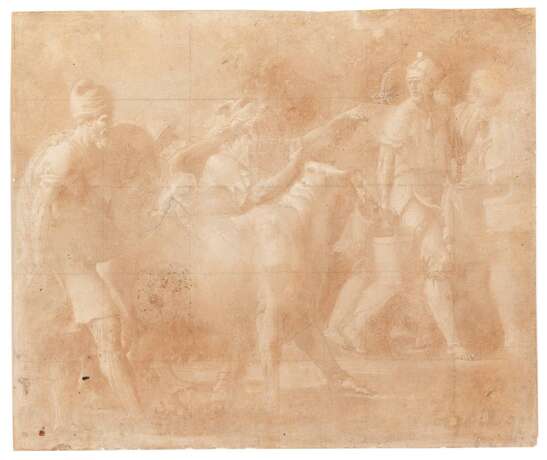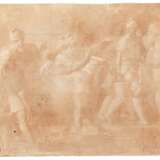ID 53103
Los 117 | École de Fontainebleau and school of Francesco Primaticcio
Schätzwert
€ 3 000 – 4 000
Provenance:
Collection Alfred von Wurzbach-Tannenberg (1845–1915), Vienna, Lugt 2587; private collection, Austria.
Literature:
D. Cordellier, Primatice Maître de Fontainebleau, Exh. cat. Paris, Louvre, 23rd September 2004 – 3rd January 2005, Paris 2004.
The present drawing presumably represents a scene from the Odyssey even though the visibility of the composition is somewhat difficult. The female figure with the animal - presumably a ram - in the centre of the drawing and the male figures in antique costumes may point to Circe, Ulysses and his companions. The sheet’s graphic style and the stylistic idiom of the heads refer to the surrounding of Francesco Primaticcio (Bologna 1504-1570 Paris).
As is generally known, Primaticcio was commissioned to reshape the the king’s residence in Fontainebleau which at the time was considered a „new Rome“.
The pupil and collaborator of Giuio Romano and later the heir of Rosso Fiorentino in Fontainebleau, Francesco Primaticcio was responsible for the complete decorative project of the court where he combined the formal language of Mannerism with influences from the French Renaissance. The refurnishing of the castle began under Francois I with the Galleria d’Ulisse but remained unfinished until his death. In addition, as festivals and masked balls took place, additional decorations were created for the complete lower gallery (Galeria Bassa) including the royal apartments and the graphic cabinet. Primaticcio who was responsible for the figural presentation in the various areas, created an ambitious courtly program which was inspired by an attempt to revitalize ancient mythology with an elegant and refined style. For the realization of the various projects Primaticcio called in numerous artists especially from Bologna, including Ruggiero de’Ruggieri, Vignola e Bagnacavallo Junior and Nicolò dell’Abate; the latter assisted Primaticcio in decorating the ballroom from 1522 onwards.
According to usual practice the numerous drawings of the various genres were given for execution to French and Italian artists who were specialised in the realisation of the various particular fields of decoration. The artists who are documented for the fountain of Pomona for example included Claude Badouin, Luca Penni, Charles Carmoy, Francesco Caccianemici, Giovanni Battista Ramenghi junior, detto Bagnacavallo and Bartolomeo da Miniato.
In the late 16th century it became customary to copy Primaticcios designs for painted replicas. Among them were copies of the frescoes of the Odyssey in the Grand Gallery. In particular the ones by Ruggiero de‘Ruggeri whose style was also formed by Pelegrino Tibaldi show quite good translations of Primaticcio’s chiaroscuro effects and graphism.
The present drawing was executed presumably in connection with the Ulysses frescoes which were everywher well known through the distribution via copies and engravings. They can therefore be attributed to an artist in the wider circle of Primaticcio in the late 16th century.
We are grateful to Dott. Maria Cristina Chiusa for the scientific support in regard of cataloguing the present drawing.
The buyer‘s premium shall be as follows:
a) for items subject to margin tax (not specially marked in the catalogue/in the description) or for sales where the Dorotheum acts as an agent (marked with a “V” [“Vermittlung” = agent sale] in the catalogue/in the description):
■ up to an amount of EUR 100,000: 25% of the hammer price
■ for the amount exceeding EUR 100,000: 22%
■ for the amount exceeding EUR 600,000: 15%
In these cases the buyer‘s premium includes the statutory VAT
b) for fully taxable items (marked in the catalogue/in the description with the symbol „+“ for 20% VAT, with „–“ for 13% VAT or with „#“ for 10% VAT):
■ up to a hammer price of EUR 100,000: 20,84% of the hammer price
■ for the amount exceeding EUR 100,000: 18,34%
■ for the amount exceeding EUR 600,000: 12,5%
In the case under (b), the statutory VAT is calculated based on the total price (hammer price plus buyer‘s premium and a possible resale right royalty) and is added to the total price.
| Adresse der Versteigerung |
Palais Dorotheum Dorotheergasse 17 1010 Wien Australien | ||||||||||||||
|---|---|---|---|---|---|---|---|---|---|---|---|---|---|---|---|
| Vorschau |
| ||||||||||||||
| Telefon | +43 01 515600 | ||||||||||||||
| Fax | +43-1-515 60-443 | ||||||||||||||
| Nutzungsbedingungen | Nutzungsbedingungen | ||||||||||||||
| Zahlungsarten |
Banküberweisung | ||||||||||||||
| Geschäftszeiten | Geschäftszeiten
|




